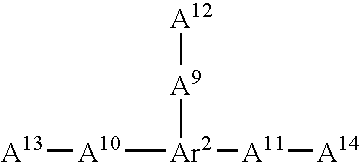Organic electroluminescence device and organic light emitting medium
a technology of organic light emitting medium and electroluminescence device, which is applied in the direction of luminescence screen, discharge tube luminescence screen, natural mineral layered products, etc., can solve the problems of insufficient light emission efficiency and life, inability to use organic el device using this material for practical applications, and insufficient life and properties
- Summary
- Abstract
- Description
- Claims
- Application Information
AI Technical Summary
Benefits of technology
Problems solved by technology
Method used
Image
Examples
example 1
On a glass plate having a size of 25×75×1.1 mm, a transparent electrode made of indium tin oxide and having a thickness of 120 nm was formed. After the glass substrate was cleaned by irradiation with ultraviolet light and exposure to ozone, the glass substrate was placed in a vacuum vapor deposition apparatus.
After N,N′-bis[4-(diphenylamino)phenyl]-N,N′-diphenylbiphenyl-4,4′-diamine was vapor deposited so that a hole injecting layer having a thickness of 60 nm was formed, N,N,N′,N′-tetrakis(4-biphenyl)-4,4′-benzidine was vapor deposited on the formed hole injecting layer so that a hole transporting layer having a thickness of 20 nm was formed. Then, compound (EM4) shown above as component (B) and compound (EM83) shown above as component (A) were simultaneously vapor deposited in amounts such that the ratio of the amount by weight of component (B) to the amount by weight of component (A) was 40:3 so that a light emitting layer having a thickness of 40 nm was formed.
On the formed...
examples 2 to 19
Organic EL devices were prepared in accordance with the same procedures as those conducted in Example 1 except that compounds shown in Table 1 were used as component (B) and component (A). The results of testing the obtained devices by passing an electric current at a current density of 10 mA / cm2 are shown in Table 1. The half-life times obtained by the test of continuous passage of a direct current at initial luminances shown in Table 1 are also shown in Table 1.
example 20
An organic EL device was prepared in accordance with the same procedures as those conducted in Example 1 except that compounds shown in Table 2 were used as component (B) and component (A) and Alq:Cs / Al was used as the cathode. Alq:Cs / Al was a mixed layer containing Alq and Cs (cesium) metal as the electron transporting compounds in relative amounts by mole of 1:1. The results of testing the obtained device by passing an electric current at a current density of 10 mA / cm2 are shown in Table 2. The half-life time obtained by the test of continuous passage of a direct current at the initial luminance shown in Table 2 is also shown in Table 2.
PUM
| Property | Measurement | Unit |
|---|---|---|
| Thickness | aaaaa | aaaaa |
| Electric potential / voltage | aaaaa | aaaaa |
| Electric potential / voltage | aaaaa | aaaaa |
Abstract
Description
Claims
Application Information
 Login to View More
Login to View More - R&D
- Intellectual Property
- Life Sciences
- Materials
- Tech Scout
- Unparalleled Data Quality
- Higher Quality Content
- 60% Fewer Hallucinations
Browse by: Latest US Patents, China's latest patents, Technical Efficacy Thesaurus, Application Domain, Technology Topic, Popular Technical Reports.
© 2025 PatSnap. All rights reserved.Legal|Privacy policy|Modern Slavery Act Transparency Statement|Sitemap|About US| Contact US: help@patsnap.com



